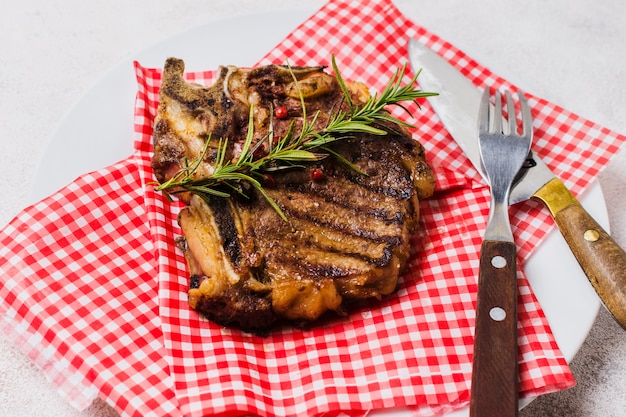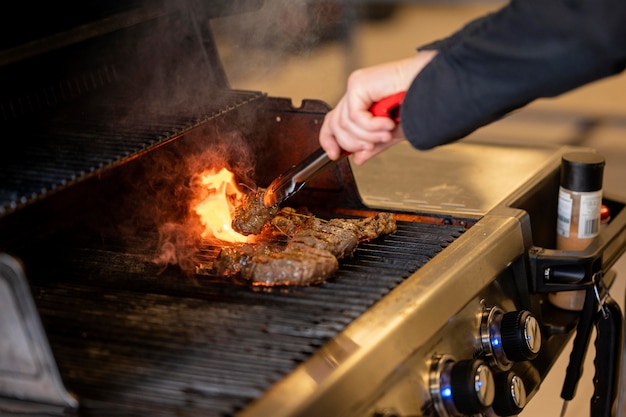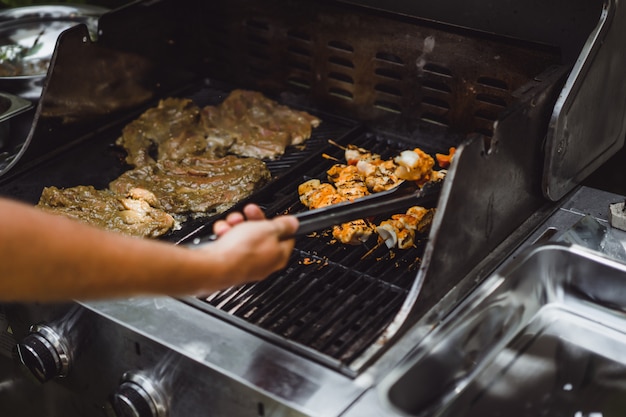rib eye steak. Just the name conjures up images of juicy, marbled goodness, a symphony of flavors that makes your mouth water. It's the king of cuts, a crowd-pleaser that never fails to impress. But achieving that perfect rib eye, with its tender interior and crispy exterior, is an art form. It's not just about throwing a steak in the oven and hoping for the best. It's about understanding the nuances of the meat, the power of the oven, and the magic of seasoning.
Over the years, I've experimented with countless techniques, learned from my mistakes, and discovered the secrets to consistently baking rib eye steak that melts in your mouth. And I'm excited to share those secrets with you! Buckle up, it's going to be a delicious journey.
(Part 1) The Meat: Choosing Your Weapon

Before you even think about preheating the oven, you need the right weapon for the job – a beautiful, high-quality piece of rib eye steak.
Picking the Right Cut
For me, rib eye is the ultimate cut. That perfect balance of marbling and tenderness makes it a true king. However, if you're feeling adventurous, there are other fantastic cuts that deserve your attention:
- strip steak: Leaner than rib eye, with a slightly more pronounced flavor. Perfect for those who prefer a bit more bite.
- T-bone Steak: A classic for a reason. This cut combines the tenderloin, which is lean and delicate, with the strip, offering a contrast of textures and flavors.
- Porterhouse Steak: Essentially a T-bone on steroids. It's bigger and boasts a larger strip section, making it a real showstopper.
The Thickness Factor
Now, you can absolutely bake a thinner steak, but for the best results, you want a cut at least 1.5 inches thick. This allows for a beautiful sear on the outside while ensuring the interior cooks evenly and stays juicy.
The "Dry-Aging" Debate
If you're looking to elevate your steak game to a whole new level, dry-aged beef is worth exploring. It's a process where beef is aged in a controlled environment for several weeks, developing a more intense, concentrated flavor and a tender texture. However, it's an investment, both in terms of time and budget. But if you're a true steak enthusiast, it's a must-try.
The "Marbling" Magic
The key to a flavorful, tender steak lies in marbling – those beautiful veins of fat interspersed throughout the meat. They add flavor, juiciness, and tenderness. Look for a steak with a good amount of marbling, and you'll be rewarded with a truly delicious meal.
(Part 2) The Oven: Your Fiery Companion

The oven is your culinary sidekick in this process, responsible for delivering that perfect sear and cooking the steak to your desired doneness.
Preheating the Oven
The first rule of oven-baked steak is to preheat your oven to a scorching 400°F (200°C). This intense heat is crucial for achieving that beautiful, crispy exterior. Let the oven heat up thoroughly, giving it a good 15-20 minutes to reach its peak temperature.
Using a Baking Sheet
A baking sheet is your go-to for this task. It's sturdy, reliable, and capable of handling the intense heat. But you don't want your steak sitting directly on the sheet. To ensure even cooking and prevent sticking, elevate the steak with a wire rack or a couple of crumpled pieces of foil.
The Power of a Thermometer
Never underestimate the importance of a meat thermometer. It's the only way to ensure you achieve the perfect internal temperature for your steak. Aim for 130-135°F (54-57°C) for a medium-rare steak, but remember, your desired doneness is completely up to you.
(Part 3) The Seasoning: A Symphony of Flavors

Now, let's talk about the symphony of flavors that will bring your steak to life.
Salt and Pepper: The Essential Duo
Salt and pepper are the foundation of any great steak. Season generously, but do it about an hour before you bake the steak. This gives the salt time to draw out moisture and enhance the natural flavors of the meat.
Beyond the Basics
While salt and pepper are the essential duo, don't be afraid to explore a world of additional flavors. Here are some of my favorite spices to add complexity and depth to your steak:
- Garlic Powder: A subtle, savory kick that complements the richness of the steak.
- Onion Powder: Adds a delightful depth of flavor, reminiscent of caramelized onions.
- Paprika: Smoky and sweet, with a touch of warmth.
- Chili Powder: For those who enjoy a bit of heat, chili powder adds a subtle kick without overpowering the steak.
- Herbs: Fresh rosemary, thyme, and oregano add a wonderful aroma and a touch of earthy flavor.
The Art of Rubs
For a more complex flavor profile, consider creating your own spice rub. Combine a selection of your favorite spices and herbs, and pat it generously onto the steak. Experiment with different combinations to find your perfect flavor profile.
(Part 4) The Baking Process: Turning Up the Heat
Now, it's time to put your fiery oven to work.
Sealing the Deal
Slide your seasoned steak onto the baking sheet and into the hot oven. The first step is to sear the outside, creating a beautiful, flavorful crust that will lock in all those juicy juices. Aim for 10-15 minutes on each side, watching for that beautiful brown crust to form.
The Internal Temperature Game
Once the steak has a beautiful crust, use your trusty meat thermometer to check the internal temperature every few minutes. Remember, we're aiming for medium-rare, which is around 130-135°F (54-57°C).
The Resting Ritual
Resist the urge to slice into the steak immediately after it's cooked. Give it a good 10-15 minutes to rest. This allows the juices to redistribute, making for a more tender and flavorful steak.
(Part 5) The Finishing Touches: Adding a Touch of Magic
Now, let's take your steak to the next level with some finishing touches.
Butter Basting: A Culinary Delight
While the steak is resting, melt a tablespoon or two of butter in a small saucepan. Add a sprig of rosemary, a clove of garlic, and a pinch of salt and pepper. Once the butter is melted, drizzle it over the steak, creating a beautiful, flavorful glaze.
The Garlic Herb Butter Explosion
For a more intense flavor, consider making a garlic herb butter. Combine softened butter with minced garlic, chopped herbs (rosemary, thyme, parsley are great choices), salt, and pepper. Spread this mixture over the steak after it has rested, letting the flavors meld together.
(Part 6) Serving Up Perfection: A Feast for the Senses
Your steak is now ready to take center stage.
The Sizzling Showcase
Slice the steak against the grain, revealing those beautiful, juicy layers. Arrange the slices on a plate, letting the aroma of the steak fill the room.
The Perfect Accompaniments
No steak is complete without the perfect supporting cast of sides. Here are some of my favorites to pair with your oven-baked masterpiece:
- mashed potatoes: Creamy, comforting, and a perfect complement to the richness of the steak.
- Roasted Vegetables: Asparagus, broccoli, Brussels sprouts, or a medley of root vegetables, roasted to perfection, add color, texture, and flavor.
- Green Salad: A refreshing counterpoint to the richness of the steak, providing a burst of freshness.
- Garlic Bread: Crunchy on the outside, soft on the inside, and bursting with garlicky goodness.
A Toast to Deliciousness
Pour yourself a glass of your favorite red wine, gather your loved ones around the table, and savor every bite of this culinary triumph.
(Part 7) Troubleshooting: Tackling the Challenges
Baking a perfect steak isn't always a smooth ride. Here's how to handle a few common challenges:
The Overcooked Disaster
It happens to the best of us – you get distracted, lose track of time, and the steak ends up a little more well-done than you intended. Don't panic! Slice the steak a bit thinner to help make it more tender.
The Undercooked Dilemma
On the flip side, what if your steak is a bit undercooked? Simply pop it back in the oven for a few more minutes until it reaches your desired temperature. Just watch it closely, as it can quickly go from undercooked to overcooked.
The Dry Steak Tragedy
A dry steak is a culinary crime. But it's not a hopeless situation. Slice the steak thinly and add a bit of sauce or gravy to infuse it with moisture. A drizzle of olive oil or melted butter can also help revive a dry steak.
(Part 8) FAQs: Answering Your Burning Questions
Q: How long should I let the steak rest before cutting?
A: A good rule of thumb is to let the steak rest for 10-15 minutes. This gives the juices time to redistribute, resulting in a more tender and flavorful steak.
Q: What happens if I don't let the steak rest?
A: If you don't let the steak rest, the juices will run out when you cut it, leaving you with a dry and disappointing steak.
Q: How can I tell if the steak is cooked to my liking?
A: A meat thermometer is the most accurate way to ensure your steak is cooked to your liking. But if you don't have one, try the "touch test." Press the center of the steak. If it's soft and springy, it's rare. If it's firm, it's medium. And if it's hard, it's well-done.
Q: What if my steak is too thick for my oven?
A: If your steak is too thick for your oven, you can sear it in a pan on the stovetop before finishing it in the oven. This will help create a beautiful crust and ensure even cooking.
Q: Can I cook multiple steaks at the same time?
A: Absolutely! Just make sure the steaks are evenly spaced on the baking sheet so they cook evenly.
(Part 9) My Personal Touch: A culinary journey
Baking the perfect rib eye steak is not about rigidly following a recipe. It's about exploring, experimenting, and discovering what works best for you. It's about letting your creativity flow in the kitchen. For me, it's about sharing a piece of culinary happiness with those I love.
Over the years, I've experimented with different techniques, spices, sides, and even ventured into the world of marinades. Some have been hits, others have been misses. But that's part of the fun! It's about discovering new flavors, exploring culinary possibilities, and sharing those experiences with loved ones.
So, go on, give it a go! Grab that beautiful cut of rib eye, let your oven be your fiery companion, and create your culinary masterpiece. You might surprise yourself with what you can achieve. And remember, every time you bake a rib eye steak, you're not just cooking a meal; you're creating an experience.
Everyone is watching

How to Cook Frozen Lobster Tails Perfectly: A Step-by-Step Guide
RecipesLobster. Just the word conjures up images of lavish meals, special occasions, and a taste of luxury. But let's...

Pigs in a Blanket Cooking Time: How Long to Bake for Perfect Results
RecipesAh, pigs in a blanket. Just the name conjures up images of those delightful little parcels of crispy pastry en...

Pork Fillet Cooking Time: How Long to Cook It Perfectly
RecipesPork fillet, or tenderloin as it's sometimes called, is a real favourite in our house. It's so versatile, and...

The Ultimate Guide to Cooking Delicious Frankfurters
RecipesLet's face it, we all love a good frankfurter. It's a classic, simple, and always satisfying. But let's be rea...

Wolf Meat Recipes: A Guide to Cooking Wild Game
RecipesLet's be honest, you don't see wolf meat at your local butcher shop every day. It's a bit of a wild card, but ...
